Related Research Articles

The United States Air Force Academy (USAFA) is a United States service academy in El Paso County, Colorado, immediately north of Colorado Springs. It educates cadets for service in the officer corps of the United States Air Force and United States Space Force. It is the youngest of the five service academies, having graduated its first class 65 years ago in 1959, but is the third in seniority. Graduates of the academy's four-year program receive a Bachelor of Science degree and are commissioned as second lieutenants in the U.S. Air Force or U.S. Space Force. The academy is also one of the largest tourist attractions in Colorado, attracting approximately a million visitors each year.
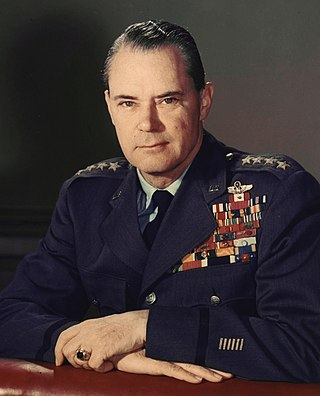
Hoyt Sanford Vandenberg was a United States Air Force general. He served as the second Chief of Staff of the Air Force, and the second Director of Central Intelligence.

Laurence Carbee Craigie, was a United States aviator and United States Air Force general. He became the first U.S. military jet pilot in 1942 when he piloted the Bell XP-59. With Orval R. Cook he is also known as one half of the Cook-Craigie plan, a method of producing aircraft.

Valley Forge Military Academy and College (VFMAC) is a private boarding school and military junior college in Wayne, Pennsylvania. It follows in the traditional military school format with army traditions. Though military in tradition and form, the high school portion of VFMAC, Valley Forge Military Academy, is a college-preparatory boarding institution specializing in student leadership. VFMAC's administration is composed almost entirely of current or retired military and the board of trustees is almost entirely alumni. Some graduates pursue careers in the armed services and VFMAC has graduated one Rhodes Scholarship recipient.

Donald L. Harlow was a senior enlisted airman of the United States Air Force who served as the 2nd Chief Master Sergeant of the Air Force from 1969 to 1971.
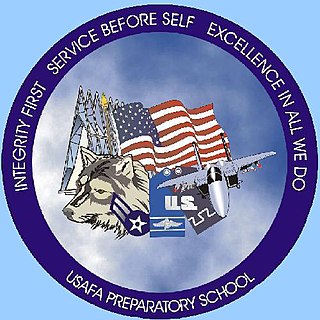
The U.S. Air Force Academy Preparatory School—usually referred to as "the Prep School" or "The P School"—was established in May 1961. The school's founder and first commander was Colonel Lee Charles Black. It is located on the campus of the United States Air Force Academy near the Community Center. The Prep School's mission is to prepare, motivate, and evaluate for admission to and success at the Air Force Academy. Students at the prep school are referred to as "cadet candidates" or more informally as "preppies."

Michelle D. Johnson is a retired lieutenant general in the United States Air Force and former senior vice president and head of referee operations for the National Basketball Association.

Thomas Webster Steed was a professional U.S. military officer in the United States Army Air Corps, Army Air Forces, and Air Force. During World War II he commanded the 456th Bomb Group (Heavy) throughout its combat service, one of only three bomb group commanders to train a group, command it overseas, and return it to the United States.

Santa Ana Army Air Base (SAAAB) was a World War II-era air base located near Santa Ana, California. The air base was decommissioned in 1946, and part of the land was annexed by Costa Mesa in 1953. The air base was used for basic training, although it did not have planes, hangars or runways. The base was 1,336 acres (5.41 km2), and the main section of the base was located between Baker Street to the north, Harbor Boulevard to the west, Wilson Street on the south, and Newport Boulevard on the east. The land formerly occupied by the air base is today the home of John Wayne Airport, the Orange County Fairgrounds, and Orange Coast College.

The Australian Defence Force Academy (ADFA) is a tri-service military Academy that provides military and academic education for junior officers of the Australian Defence Force in the Royal Australian Navy (RAN), Australian Army and Royal Australian Air Force (RAAF). In 2016 the Academy began accepting civilian students in its undergraduate courses.
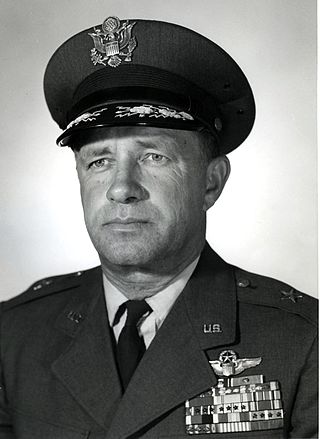
Brigadier General Harrison Reed Thyng was a fighter pilot and a general in the United States Air Force (USAF). He is notable as one of only six USAF fighter pilots to be recognized as an ace in two wars. On retiring from the military, Thyng became a New Hampshire candidate to the United States Senate.

Thomas Samuel Moorman Jr. was a United States Air Force officer who served as Vice Chief of Staff of the United States Air Force from July 1994 to August 1997.
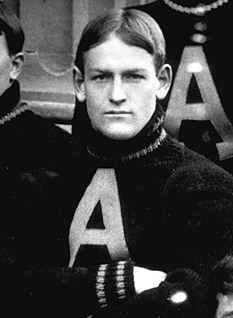
Paul Delmont Bunker was an American football player and soldier. Bunker attended the U.S. Military Academy and became the first football player at West Point to be selected as a first-team All-American by Walter Camp. Bunker was chosen as an All-American at the tackle position in 1901 and repeated as an All-American in 1902, but as a halfback. He served in the U.S. Army for 40 years and was in command of the coastal artillery forces in the Battle of Corregidor. On the fall of Corregidor, Bunker became a prisoner of war. He died of starvation and disease in a Japanese prison camp in 1943 after losing 70 pounds at the age of 61. His posthumously published journal, Paul Bunker's Diary, became a best-seller. He was elected to the College Football Hall of Fame in 1969.

John Jay "Big John" Kissell was an American football defensive tackle who played for the Buffalo Bills in the All-America Football Conference (AAFC) and the Cleveland Browns in the National Football League (NFL) in the 1940s and 1950s. He played college football at Boston College.

Major General Edward Leonard King was an American football player and coach and officer in the United States Army. He played college football as the halfback at the United States Military Academy from 1894 to 1895 and served as the head coach of the Army football team in 1903. King was a career military officer who served in the Spanish–American War and World War I. He was the Commandant of the United States Army Command and General Staff College from 1925 to 1929 and attained the rank of major general.
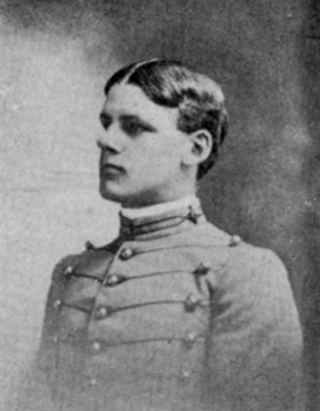
Edward Ellis Farnsworth was an American football player, an officer in the United States Army and a member of the Maine State Highway Commission. He was thrice selected as an All-American and is the only individual to have played in five Army–Navy Games. He was, additionally, an author and Theosophist.

Thomas James Bell was an American football player. He played for the Army Cadets football teams from 1950 to 1954 and was the first Army player to rush for 1,000 yards in a season. He was selected as a first-team halfback on the 1954 All-America college football team.
The 1941 Army Cadets football team represented the United States Military Academy in the 1941 college football season. In their first year under head coach Earl Blaik, the Cadets compiled a 5–3–1 record and outscored their opponents by a combined total of 105 to 87.
The 1942 Army Cadets football team represented the United States Military Academy in the 1942 college football season. In their second year under head coach Earl Blaik, the Cadets compiled a 6–3 record and outscored their opponents by a combined total of 149 to 74. In the annual Army–Navy Game, the Cadets lost to the Midshipmen by a 14 to 0 score. The Cadets also lost to Penn and Notre Dame.

2LT Wallace Patillo Reed was a World War II U.S. Army officer, U.S. military meteorologist, and the first ever African-American meteorologist in the U.S. military. Reed served at Tuskegee Army Air Field in Alabama as the chief weather officer responsible for the all-African American Tuskegee Airmen. Reed regularly advised Tuskegee Airmen pilots and instructors on weather maps and forecasts.
References
- 1 2 3 4 "Henry J. Mazur Class of 1937". Lowell High School Athletic Hall of Fame. Retrieved February 4, 2015.(profile includes extensive archive of newspaper clippings and other biographical material on Mazur; much of the content herein is sourced to those biographical materials)
- ↑ Social Security Death Index for Henry J. Mazur, last residence, Nashua, New Hampshire, born Nov 9, 1919, died Mar 26, 1988.